- Some people feel stressed or anxious when they are in a clinical or hospital setting. This phenomenon is called the “white coat syndrome” in reference to the white coats often worn by health professionals. People may also feel anxious about finding out their results. Taking the measurement at home provides a more accurate picture of your blood pressure.
- Blood pressure measurements taken at home provide a good indication of whether medication to treat high blood pressure needs to be prescribed, modified or continued.
- Home measurements can show if you have achieved the target blood pressure that your health professional has recommended. Do you know what your target numbers are? If you don’t, find out! You’ll be more motivated to follow recommendations if you know what you’re aiming for.
Physical examination and tests
In order to determine if you are suffering from hypertension, your blood pressure must be accurately measured.
How is blood pressure measured?
First of all, it is important to know that there are several factors that can cause your blood pressure to fluctuate:
- Physical effort
- Emotions
- Alcohol consumption
- If you have been smoking, eating or consuming caffeine
- Ambient temperature (very cold or very warm)
- Speaking
- Different times of the day (morning or evening)
It is therefore normal for your blood pressure to vary depending on your activities and what you are experiencing. That is why several measurements are taken to provide a more accurate portrait before making a diagnosis.
Several methods are used to measure blood pressure.
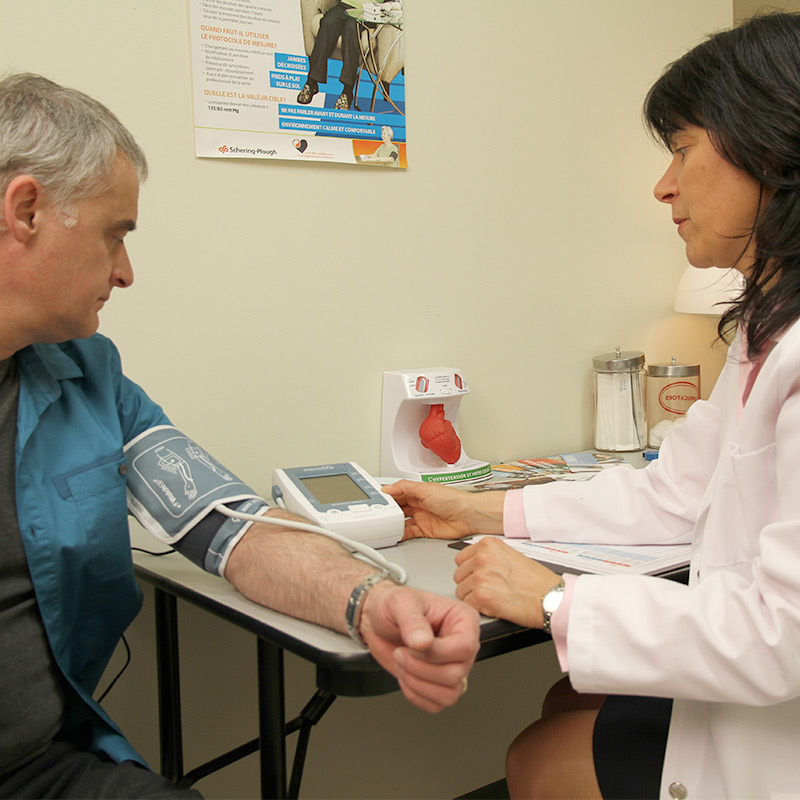
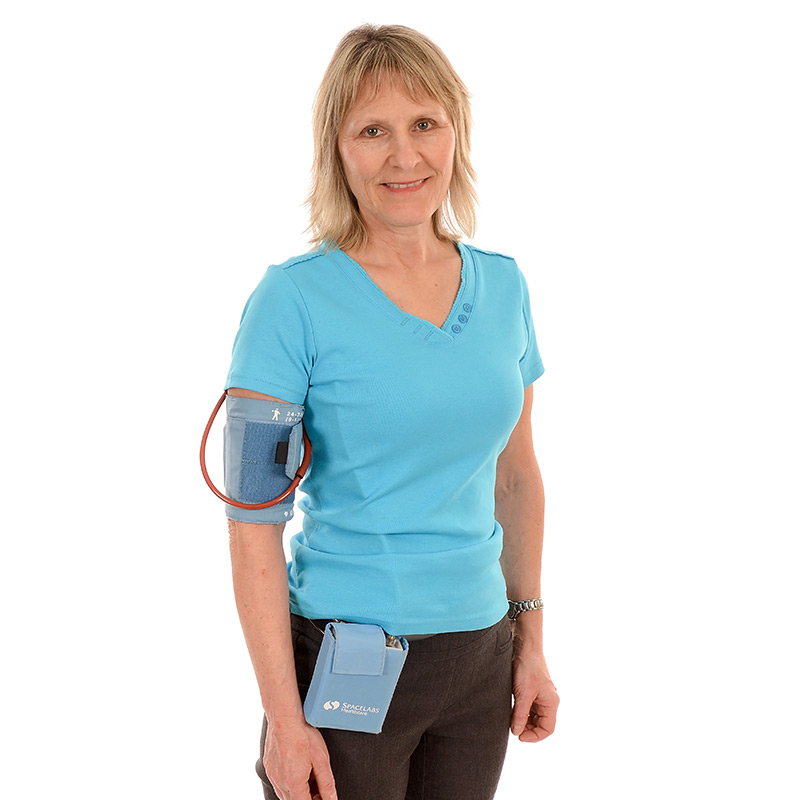
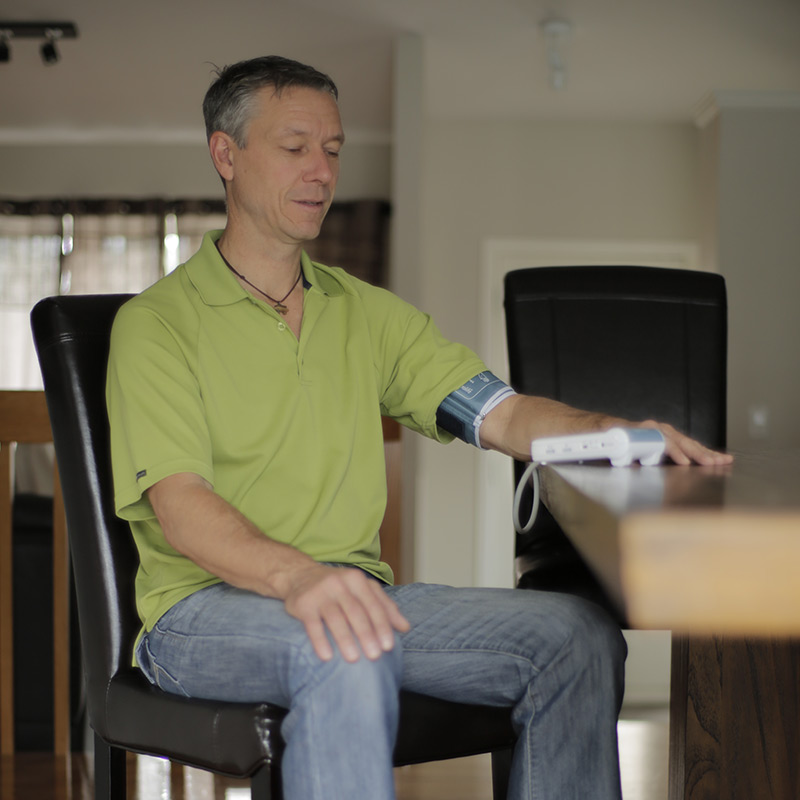
When is it necessary to measure blood pressure outside of a clinical setting?
Measuring blood pressure at home
What is the best device to buy?
There are several different blood pressure measurement devices on the market, some of which are more technologically advanced than others. It is up to you to decide whether you want a more sophisticated product or a basic device that simply measures your blood pressure and displays the measurement. Some devices can be connected to your smartphone, tablet or computer, providing graphs or average blood pressure measurements over several days, which can be very interesting if you are familiar and comfortable with these new technologies.
It is absolutely essential that the device you choose has been approved by Hypertension Canada. That tells you that the numbers will be accurate and reliable.
There are two ways to identify approved devices:
- If you are purchasing a device in a store, look for the Hypertension Canada logo on the box and/or in the documentation provided with the device.


- Online, check out your device on the Hypertension Canada website.
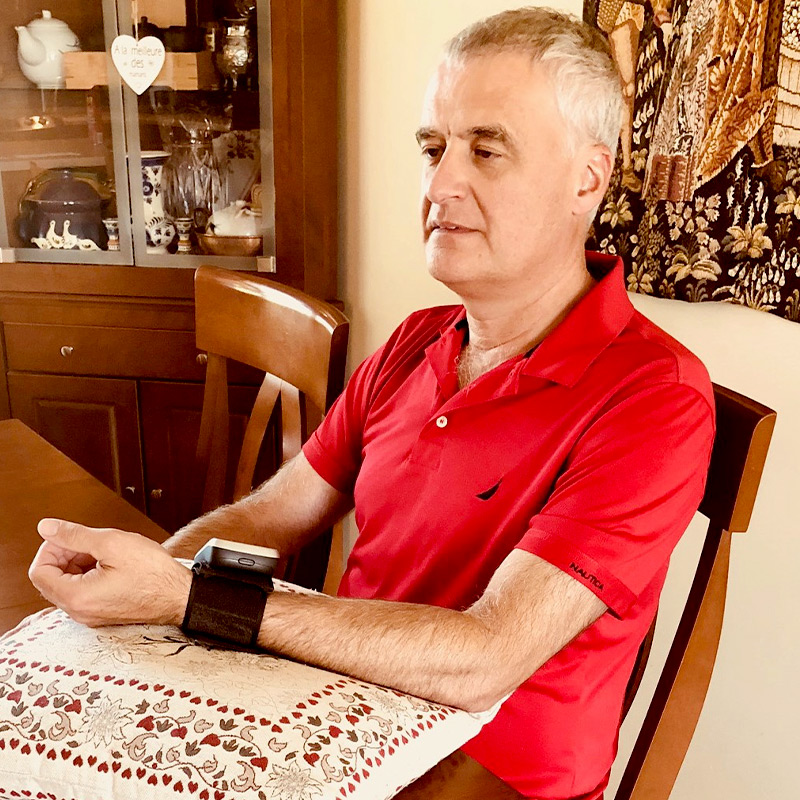
Wrist blood pressure measurement devices may be used if the patient’s arm is too large for the standard cuffs that are usually provided. Examples of approved devices of this type are presented on the Hypertension Canada website.
It is not possible for your health professional to ensure your device is valid other than by looking to see if the model appears on the list of approved devices. It would be a good idea, however, to consult with him or her to make sure you are taking your measurements correctly and at the appropriate time of day. Your health professional will also be able to check that you are using the correct cuff and that your device is in good working order (condition of the Velcro, tubing, etc.).
What size of cuff should you choose?
It is important to select the correct cuff size:
If the cuff is too small Results will be too high
If the cuff is too large Results will be too low
The cuff must be wrapped snugly around your bare upper arm without squeezing it. You may keep your sleeve down if you are wearing a lightweight shirt or sweater as long as you are careful not to squeeze your arm above the cuff. Do not place the cuff over a sleeve made of thick fabric.
Don’t hesitate to ask a health professional for assistance.
Make sure the cuff is easy to put on, that the numbers are clearly legible on the device display, and that the device comes with an electric cord. Plugging in your monitoring device instead of using batteries will be more economical.
When should I measure my blood pressure?
- when you get up, before you have eaten or taken medication
Twice in the evening
- two consecutive measurements two hours after your evening meal
Take a one-minute pause before taking the second measurement.
How should I prepare myself before taking my blood pressure?
- Refrain from smoking, exercising, eating or consuming caffeine for at least 30 minutes before you take your measurement.
- Use the toilet (to empty your bladder or bowels if necessary).
- Put on the cuff correctly:
- The lower edge of the cuff must be about 3 cm above your elbow crease.
- Your arm must be bare or in a lightweight shirt or sweater (avoid squeezing your arm with the fabric of your clothing).
- Adopt the correct position:
- Seated
- Back supported
- Legs uncrossed
- Feet flat on the floor
- Arm supported on a table or firm surface
- Cuff at the level of your heart
You may need to place a cushion on your chair or under your arm to ensure that your arm is at the correct height. Do not hesitate to do so.
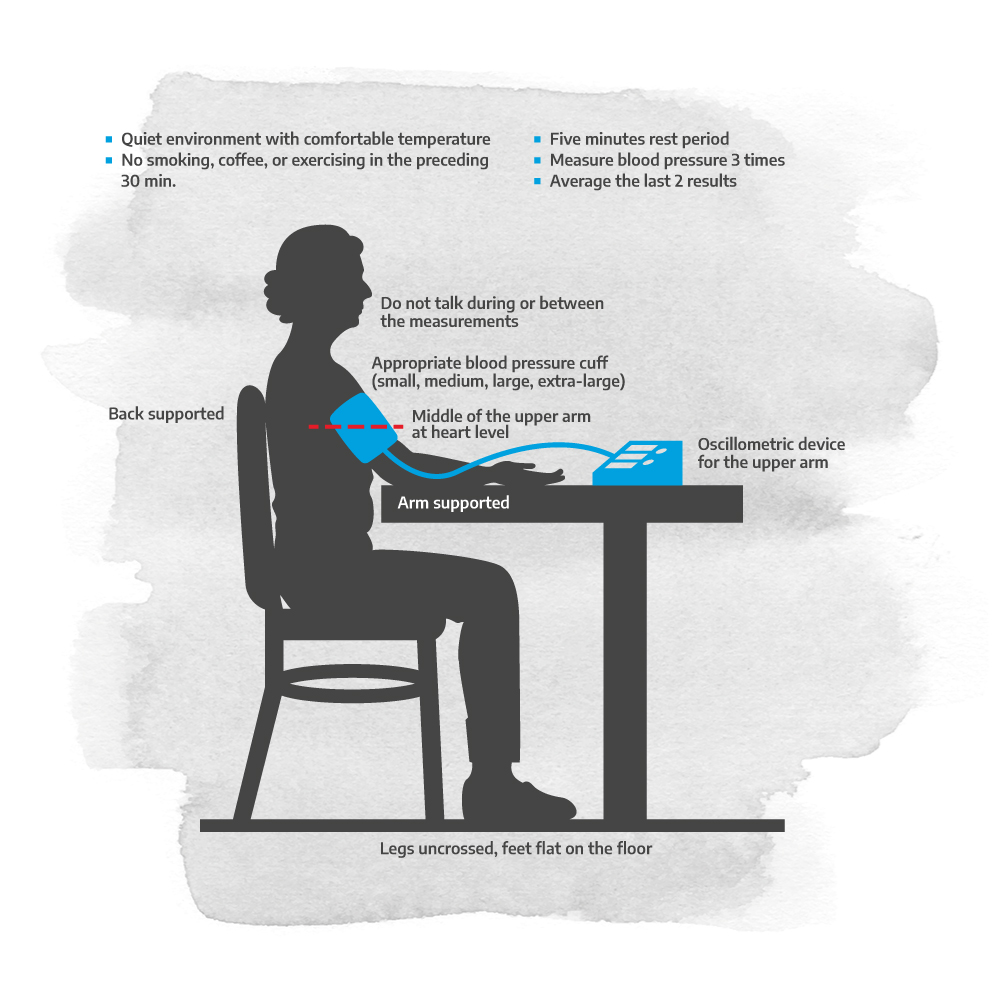
- Maintain a calm environment.
- Put phones, tablets and TV screens away and out of sight.
- Don’t talk while measuring your blood pressure.
How to measure your blood pressure
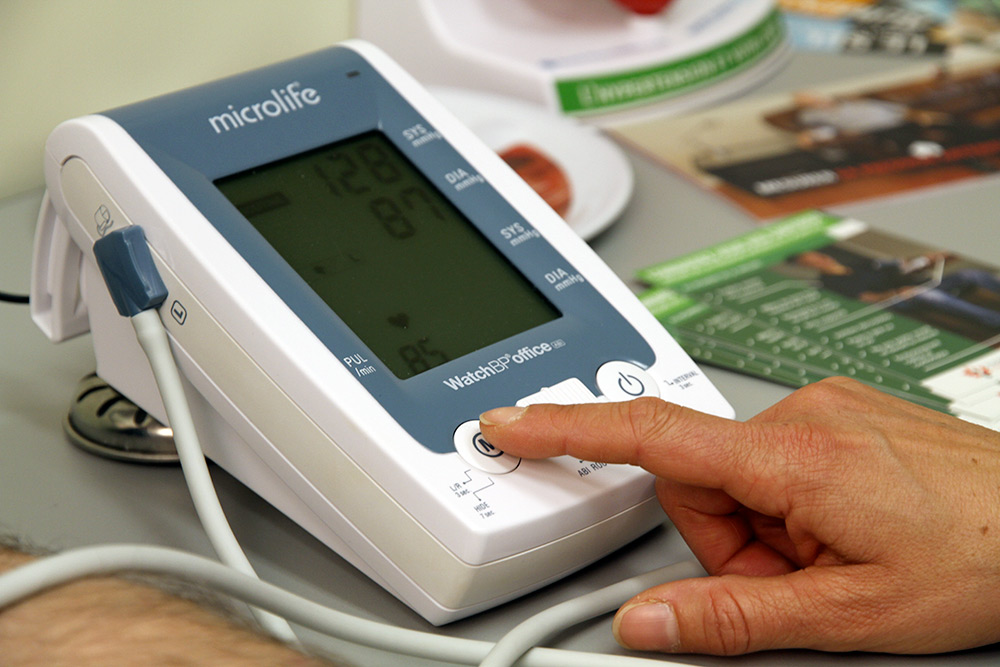 Did you know that your blood pressure may be different in each arm? Ask your health professional which arm you should use. If you don’t have that information, keep your dominant arm (the one you use to perform most tasks) free to manipulate the device. That means that you will be measuring the blood pressure in your other, non-dominant arm.
Did you know that your blood pressure may be different in each arm? Ask your health professional which arm you should use. If you don’t have that information, keep your dominant arm (the one you use to perform most tasks) free to manipulate the device. That means that you will be measuring the blood pressure in your other, non-dominant arm.
Slide the cuff onto your upper arm so that the tube is at the bottom, going toward your hand. Then position the cuff so that the artery mark or arrow is directly over the brachial artery. The mark will be almost directly in line with the little finger of your outstretched hand.
Fasten the cuff, adjusting it so that it is snug but not too tight. You should be able to slide two fingers underneath the cuff when it is fastened.
Then press the button to start the device and let it take your measurement.
How should I keep track of my results?
The final step in measuring your blood pressure consists in recording your results – either by writing it on paper or by entering the figure in an electronic document (see the example below). Many people who measure their blood pressure on a regular basis report that they rarely manage, for one reason or another, to take their pressure for seven days in a row without missing a measurement. This is completely normal.
The more measurements you take, the better. If you forget or are busy, just write an “X” on your chart or enter nothing at all in your electronic document.
All results must be recorded. Don’t try to decide which ones are “good” or “bad.” All results are of interest in that they will help us understand how to help you better.
You can print the sheet and record your results with a pencil. Take this sheet to your healthcare professional the next time you visit.
You can also save the Excel file to your computer. It will automatically average your results and you will then be able to obtain your measurement report automatically.
Ambulatory blood pressure monitoring (ABPM)
Although this type of test is often used for an initial diagnosis of high blood pressure, it is also used to monitor a new treatment or if you are experiencing specific forms of discomfort, such as dizziness or abnormal fatigue on waking up.
If your health professional wants to know your blood pressure numbers during both the day and the night, he or she may prescribe a test called “ambulatory blood pressure monitoring,” or ABPM. This test shows how your blood pressure varies during a 24-hour period. You will be asked to go through your day and night in the usual way, without changing any of your usual habits.
Since blood pressure is usually lower at night, the average obtained with ABPM is usually lower than measurements obtained in a medical setting.
Normal values in medical setting should be lower than < 140/90 mm Hg
Normal values for 24-hour ABPM should be lower than < 130/80 mm Hg
The ABPM test report will also include the average of the numbers obtained during the day; normal values should be lower than 135/85 mm Hg.
How the test works
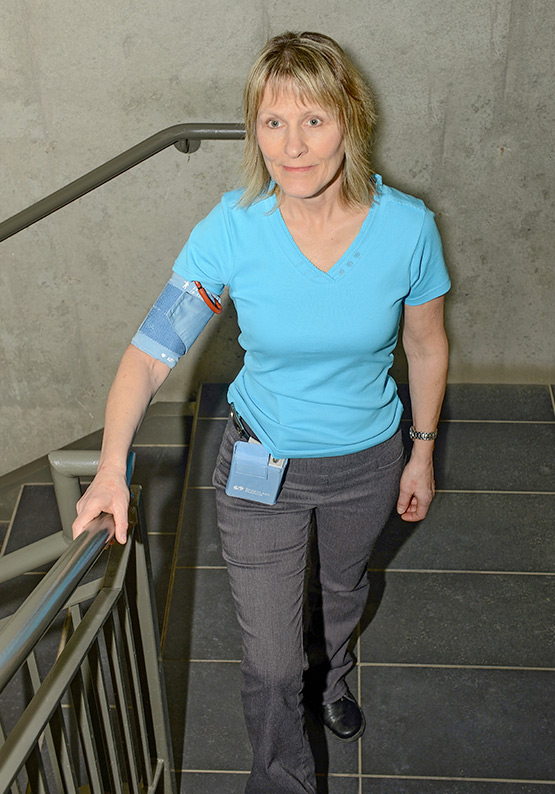
You will be given a small monitoring device that sits in a pouch attached to a waist belt or shoulder strap. The device is connected to a cuff secured around your upper arm. A health professional will get you organized and turn on the device, which is programmed to measure your blood pressure at regular intervals. Every 20 or 30 minutes for an entire day and night (24 hours), the cuff around your arm will inflate automatically in order to take your blood pressure. Some devices are equipped with an alarm to notify you that the monitor is about to take a measurement.
What do I need to do to prepare for an ABPM?
Wear loose, short sleeves and a belt to which the monitor can be attached.
You will be asked not to remove the cuff, unless it slides completely out of position, and to avoid getting the monitoring device wet. During the night, it’s a good idea to place the device in the middle of the bed to keep it safe.
Are there any other useful tests?
In addition to taking your blood pressure, the health professional doing your follow-up may ask for certain additional tests to:
- determine the cause of your hypertension (high blood pressure);
- check if any of your organs (heart, kidneys, eyes) are showing signs of complications.
Below are examples of some of the tests used to make sure your organs are functioning properly: